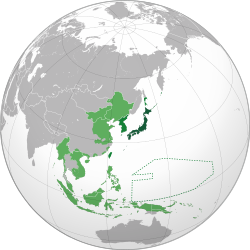Empire of Japan
The Empire of Japan[c] (Japanese : 大日本帝國) also known as Imperial Japan was a historical Nation State and great power during the period from the Meiji Restoration to the Japanese defeat in World War II. It ruled the Home Islands of Japan and many other areas. The Emperors during this time, were Emperor Meiji (Mutsuhito),from 1868-1912 and Emperor Taishō (Yoshihito) from 1912-1926 and Emperor Shōwa (Hirohito) from 1926-1989 . It is considered to go from the year 1868 to 1945. Hirohito was still emperor of Japan after the empire dissolved in 1947 . Hirohito was emperor of Japan until his death in 1989 .
Empire of Japan
| |||||||||||
|---|---|---|---|---|---|---|---|---|---|---|---|
| 1868–1947 | |||||||||||
Motto:
| |||||||||||
| Anthem: (1869–1945) "Kimigayo" (君が代) | |||||||||||
 The Empire of Japan at its peak in 1942:
| |||||||||||
| Capital |
| ||||||||||
| Largest city |
| ||||||||||
| Official languages | Japanese | ||||||||||
| Recognised regional languages | |||||||||||
| Religion | |||||||||||
| Government | Unitary parliamentary semi-constitutional monarchy (1889–1947) (de jure)[7] Unitary divine theocratic absolute monarchy (de facto)
| ||||||||||
| Emperor | |||||||||||
• 1868–1912 | Meiji | ||||||||||
• 1912–1926 | Taishō | ||||||||||
• 1926–1947 | Shōwa | ||||||||||
| Prime Minister | |||||||||||
• 1885–1888 (first) | Itō Hirobumi | ||||||||||
• 1946–1947 (last) | Shigeru Yoshida | ||||||||||
| Legislature | None (rule by decree) (1868-1871) House of Peers (1871-1889) Imperial Diet (since 1889) | ||||||||||
| House of Peers (1889-1947) | |||||||||||
| House of Representatives (from 1890) | |||||||||||
| Historical era | Meiji • Taishō • Shōwa | ||||||||||
| 3 January 1868[9] | |||||||||||
| 11 February 1889 | |||||||||||
| 25 July 1894 | |||||||||||
| 8 February 1904 | |||||||||||
| 23 August 1914 | |||||||||||
| 18 September 1931 | |||||||||||
| 7 July 1937 | |||||||||||
| 7 December 1941 | |||||||||||
| 2 September 1945 | |||||||||||
| 3 May 1947[7] | |||||||||||
| Area | |||||||||||
| 1938[10] | 1,984,000 km2 (766,000 sq mi) | ||||||||||
| 1942[11] | 7,400,000 km2 (2,900,000 sq mi) | ||||||||||
| Population | |||||||||||
• 1920 | 77,700,000a | ||||||||||
• 1940 | 105,200,000b | ||||||||||
| Currency | |||||||||||
| |||||||||||
| |||||||||||
| Japanese Empire | |||||
| Japanese name | |||||
|---|---|---|---|---|---|
| Kanji | 大日本帝国 | ||||
| Hiragana | だいにっぽんていこく だいにほんていこく | ||||
| Katakana | ダイニッポンテイコク ダイニホンテイコク | ||||
| Kyūjitai | 大日本帝國 | ||||
| |||||
In those years, Japan changed greatly. It became one of the most powerful countries in the world. Japan built a powerful army and navy, and changed from an agricultural to an industrial economy. The Japanese began to invade and occupy other near countries like Korea, Taiwan, Manchukuo and part of China to get natural resources
The Empire of Japan surrendered to the Allies on September 2, 1945, after a long war against the Allied nations of World War II ending with the atomic bombings of Hiroshima and Nagasaki. The Allies occupied the country and made many changes, including a new constitution. Allied occupation and reconstruction of the country continued well into the 1950s.
Other websites change
- Imperial Japan Archived 2007-04-09 at the Wayback Machine
- Death of the Father: Hirohito & Imperial Japan
References change
- ↑ "Explore Japan National Flag and National Anthem". Retrieved January 29, 2017.
- ↑ "National Symbols". Archived from the original on February 2, 2017. Retrieved January 29, 2017.
- ↑ Schellinger and Salkin, ed. (1996). "Kyoto". International Dictionary of Historic Places: Asia and Oceania. UK: Routledge. p. 515ff. ISBN 9781884964046.
- ↑ Josephson, Jason Ānanda (2012). The Invention of Religion in Japan. University of Chicago Press. p. 133. ISBN 978-0226412344.
- ↑ Thomas, Jolyon Baraka (2014). Japan's Preoccupation with Religious Freedom (Ph.D.). Princeton University. p. 76.
- ↑ Jansen 2002, p. 669.
- ↑ 7.0 7.1 "Chronological table 5 December 1, 1946 – June 23, 1947". National Diet Library. Retrieved September 30, 2010.
- ↑ Hunter 1984, pp. 31–32.
- ↑ "One can date the "restoration" of imperial rule from the edict of January 3, 1868." Jansen, p. 334.
- ↑ Harrison, Mark (2000). The Economics of World War II: Six Great Powers in International Comparison. Cambridge University Press. p. 3. ISBN 9780521785037. Retrieved October 2, 2016.
- ↑ Conrad, Sebastian (2014). "The Dialectics of Remembrance: Memories of Empire in Cold War Japan" (PDF). Comparative Studies in Society and History. 56 (1): 8. doi:10.1017/S0010417513000601. ISSN 0010-4175. JSTOR 43908281. S2CID 146284542. Archived (PDF) from the original on 2020-07-08. Retrieved 2020-07-07.
In 1942, at the moment of its greatest extension, the empire encompassed territories spanning over 7,400,000 square kilometers.
- ↑ 12.0 12.1 Taeuber, Irene B.; Beal, Edwin G. (January 1945). "The Demographic Heritage of the Japanese Empire". Annals of the American Academy of Political and Social Science. 237. Sage Publications: 65. doi:10.1177/000271624523700108. JSTOR 1025496. S2CID 144547927.
- ↑ Shillony, Ben-Ami (2013). Ben-Ami Shillony – Collected Writings. Routledge. p. 83. ISBN 978-1134252305.
- Notes
- ↑ Modified version used in 1880–1945.
- ↑ Although the Empire of Japan officially had no state religion,[4][5] Shinto played an important part for the Japanese state. Marius Jansen states: "The Meiji government had from the first incorporated, and in a sense created, Shinto, and utilized its tales of the divine origin of the ruling house as the core of its ritual addressed to ancestors 'of ages past'. As the Japanese empire grew the affirmation of a divine mission for the Japanese race was emphasized more strongly. Shinto was imposed on colonial lands in Taiwan and Korea, and public funds were utilized to build and maintain new shrines there. Shinto priests were attached to army units as chaplains, and the cult of war dead, enshrined at the Yasukuni Jinja in Tokyo, took on ever greater proportions as their number grew."[6]
- ↑ Japanese: 大日本帝国 Hepburn: Dai Nippon Teikoku[13]

